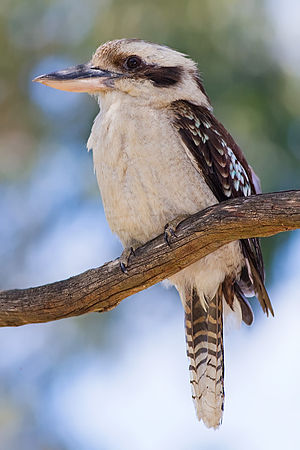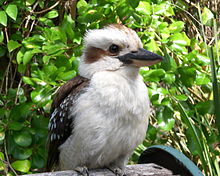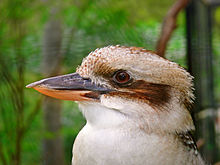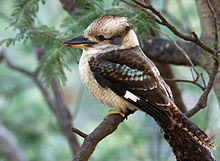- Laughing Kookaburra
-
Laughing Kookaburra 
Conservation status Scientific classification Kingdom: Animalia Phylum: Chordata Class: Aves Order: Coraciiformes Family: Halcyonidae Genus: Dacelo Species: D. novaeguineae Binomial name Dacelo novaeguineae
(Hermann, 1783)The Laughing Kookaburra, Dacelo novaeguineae, is a carnivorous bird in the kingfisher family Halcyonidae. Native to eastern Australia, it has also been introduced to parts of New Zealand, Tasmania and Western Australia. Male and female adults are similar in plumage, which is predominantly brown and white. A common and familiar bird, this species of kookaburra is well known for its laughing call.
Contents
Taxonomy
Scientific name: The Laughing Kookaburra was first described in western knowledge systems by French naturalist Johann Hermann in 1783, its specific epithet novaeguineae refers to New Guinea. For many years it was known as Dacelo gigas.
Vernacular name: Previously known as the Laughing Jackass[1][2] and Giant Kingfisher[2], today its name comes from Wiradhuri, an Aboriginal language now effectively extinct.[3]
Distribution
The Laughing Kookaburra is native to eastern mainland Australia, and has also been introduced to Tasmania, Flinders Island and Kangaroo Island.
Some were also introduced to New Zealand between 1866 and 1880, but only those released on Kawau Island by Sir George Grey survived. Descendants of these individuals are found there today.
Individuals were released at Perth, Western Australia in 1898 and can now be found throughout a wide area surrounding the city.
Description
The Laughing Kookaburra is a stocky bird of about 45 cm (18 in) in length, with a large head, a prominent brown eye, and a very large bill. The sexes are very similar, although the female averages larger and has less blue to the rump than the male. They have a white or cream-coloured body and head with a dark brown stripe through each eye and more faintly over the top of the head. The wings and back are brown with sky blue spots on the shoulders. The tail is rusty reddish-orange with dark brown bars and white tips on the feathers. The heavy bill is black on top and bone coloured on the bottom.
Call
Behaviour
Kookaburras occupy woodland territories (including forests) in loose family groups, and their laughter serves the same purpose as a great many other bird calls—to demarcate territorial borders. Most species of Kookaburra tend to live in family units, with offspring helping the parents hunt and care for the next generation of offspring.
Feeding
Catching a worm, Bruny Island, Tasmania, Australia
Kookaburras hunt much as other kingfishers (or indeed Australasian robins) do: by perching on a convenient branch or wire and waiting patiently for prey to pass by. Common prey include mice and similar-sized small mammals, large insects, lizards, small birds and nestlings, and most famously, snakes. Small prey are preferred, but kookaburras sometimes take large creatures, including venomous snakes much longer than their bodies.
Breeding
 Juvenile in a garden in Swanbourne, Western Australia
Juvenile in a garden in Swanbourne, Western Australia
During mating season, the Laughing Kookaburra, reputedly, indulges in behaviour similar to that of a Wattle Bird. The female adopts a begging posture and vocalises like a young bird. The male then offers her his current catch accompanied with an "oo oo oo" sound. However, some observers maintain that the opposite happens - the female approaches the male with her current catch and offers it to him. Either way, they start breeding around October/November. If the first clutch fails, they will continue breeding into the summer months.
They generally lay three eggs at about 2 day intervals. If the food supply is not adequate the third egg will be smaller and the third chick will also be smaller and at a disadvantage to its larger siblings. Chicks have a hook on the upper mandible, which disappears by the time of fledging. If the food supply to the chicks is not adequate the chicks will quarrel and the hook can be used as a weapon and the smallest chick can be killed by its larger siblings. If food is plentiful the parent birds spend more time brooding the chicks and so the chicks are not able to fight.
Interaction with humans
Laughing Kookaburras are a common sight in suburban gardens and urban settings, even in built-up areas, and are so accustomed to humans that they will often eat out of their hands. It's not uncommon for kookaburras to snatch food out of people's hands without warning, by swooping in from a distance. People often feed them pieces of raw meat .
See also
References
- ^ Kookaburra: the Australian Laughing Jackass aviary.owls.com
- ^ a b San Diego Zoo's Animal Bytes: Laughing Kookaburra San Diego Zoo
- ^ New Oxford American Dictionary
External links
Categories:- IUCN Red List least concern species
- Dacelo
- Birds of South Australia
- Birds of Tasmania
Wikimedia Foundation. 2010.





